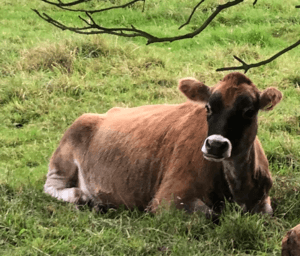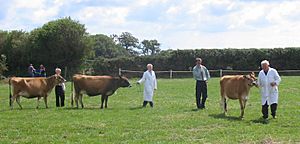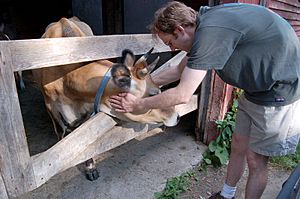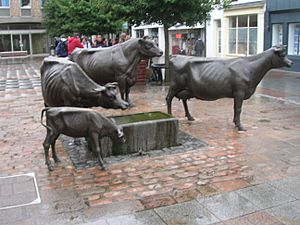Jersey cattle facts for kids

A tawny-coloured Jersey with a characteristic white ring around its red nose
|
|
| Country of origin | British Isles |
|---|---|
| Distribution | world-wide |
| Use |
|
| Traits | |
| Weight |
|
| Coat | variable |
|
|
The Jersey cow is a small type of dairy cow. It comes from the island of Jersey in the Channel Islands, which are part of Britain. It's one of three special cow breeds from the Channel Islands. The other two are the Guernsey and the Alderney, which sadly doesn't exist anymore.
Jersey cows are amazing milk producers! They can give more than 10 times their own body weight in milk each time they have a calf. Their milk has a lot of butterfat and often looks a bit yellowish.
These cows can live well in many different places and climates. Unlike many cows from cooler areas, Jersey cows handle hot weather very well. They have been sent to many countries around the world. In places like Denmark, France, New Zealand, and the United States, they have even become their own special types of Jersey cows. In Nepal, they are sometimes used as draught animals, meaning they help pull things.
Contents
The Story of the Jersey Breed
The Jersey cow breed started on the British Channel Island of Jersey. It seems they came from cows brought over from nearby Normandy in France. People first wrote about them as a separate breed around the year 1700.
For over 200 years, from 1789 to 2008, no new cattle were allowed on Jersey island. This helped keep the breed pure. Before 1789, sometimes cows were given as wedding gifts between families on Jersey and Guernsey islands.
In 1789, a law was made to stop foreign cattle from coming to Jersey. This was to keep the Jersey breed pure and protect its value. People used to ship cows from France to Jersey, then to England, to avoid taxes on French cattle. This brought down the price of Jersey cows and hurt their good name. The import ban helped keep prices stable and allowed for better breeding programs.
Sir John Le Couteur was a person who studied how to breed animals carefully. His work led to the creation of the Royal Jersey Agricultural and Horticultural Society in 1833. Back then, Jersey cows looked more varied than they do today. There were white, dark brown, and reddish-brown cows. But because honey-brown cows sold best, breeders focused on that color.
In 1860, over 1,100 cows were sent out of England to other countries. By 1910, more than 1,000 cows were sent to the United States alone each year. Today, the Jersey is the fastest-growing dairy cow breed in the world.
In 1866, the Royal Jersey Agricultural and Horticultural Society decided to start a "herd book." This book would record the family history of bulls, cows, and calves. This helped people track the best breeding lines. In 1869, prizes were given at shows for cows listed in this herd book.
In 1866, the States of Jersey counted all the cattle on the island. There were 12,037 cattle, and 611 of them were bulls.
In July 2008, the island of Jersey made a big change. They ended the ban on importing cattle. They also allowed bull semen from any breed to be imported. However, only calves from genetically pure Jersey semen can be put into the Jersey Herd Book.
For many years, each of the 12 parishes (small areas) in Jersey held cattle shows. Then, the Royal Jersey Agricultural and Horticultural Society held bigger shows where the best cows from the parish shows competed. The color of the ribbon a cow won was said to decide how much it would sell for when exported. Today, the Society holds two shows a year. A few of the remaining 23 herds compete for the top prizes. There is also a Jersey cattle show held by the West Show Association.
Around 1850, Jersey cattle started to be sent to the United States. A group called the American Jersey Cattle Club was formed in 1868. In the USA, some people talk about an "American Jersey." This type is often larger and has been bred mostly to produce a lot of milk. The original "Island" type is sometimes called a "Miniature Jersey."
What Makes Jersey Cows Special?
Jersey cows usually weigh between 400 and 500 kilograms (about 880 to 1,100 pounds). People like them for many reasons, including:
- More cows per farm: Because they are smaller, you can have more Jersey cows on the same amount of land. This means they need less food to maintain their bodies.
- Easy births: Jersey cows usually have an easier time giving birth. This makes them popular for crossbreeding with other dairy or even beef cows to help reduce problems during birth.
- Good at having calves: They are very fertile, meaning they can have calves easily.
- Rich milk: Their milk has a high amount of butterfat (about 4.84%) and protein (about 3.95%). They can also do well on local feed.
Jersey cows come in many shades of brown, from light tan to almost black. They are often a fawn (light brownish-yellow) color. All purebred Jersey cows have a lighter band around their noses. They also have a dark switch (the long hair at the end of their tail) and black hooves. However, rules about color have been relaxed recently to allow more variety in their genes.
The cows are generally calm and gentle. However, the bulls can sometimes be unpredictable or aggressive.
Jersey cattle can sometimes get a condition called "milk fever" after giving birth. Their calves can also be a bit delicate and need more care in cold weather. This is because their smaller bodies lose heat more easily than larger calves.
Famous Jersey Cows
- Brown Bessie was a famous champion butter cow at the Chicago World's Fair. She made about 1.3 kilograms (3 pounds) of butter every day for five months!
- Huronia Centurion Veronica 20J EX-97% is a very well-known show cow. In 2003, she was sold for $85,000. She was named the World Dairy Expo Supreme Champion in 2006.
- Mainstream Barkley Jubilee holds the top two records for milk production for a Jersey cow. She produced over 49,000 pounds of milk after one calving and over 55,000 pounds after another!
- Lily Flagg was a champion butterfat and milk producer in 1892. She made a record 1047 pounds of butter! Her owner even painted his house "butter yellow" to celebrate her.
- Duncan Belle was named the winner of the 2000 Great Cow Contest. She was also named the Reserve Grand Champion at a big show in 1993.
- Evie was a Jersey cow who played the main role in the 2019 movie First Cow.
- Musqie Iatola Martha EX-97% is one of the most famous show cows in the Jersey breed. She has won the Royal Agriculture Winter Fair Supreme Champion three times! She is also the youngest cow of any breed to get the highest score of EX 97.
Images for kids
-
Jersey cows near Brighstone, on the Isle of Wight
See also
 In Spanish: Ganado Jersey para niños
In Spanish: Ganado Jersey para niños






